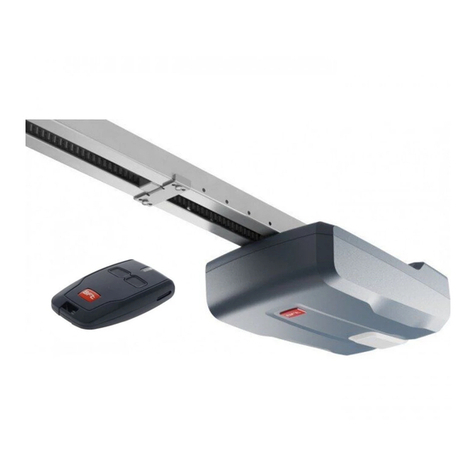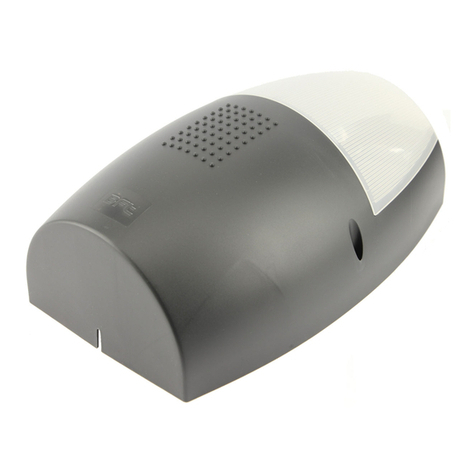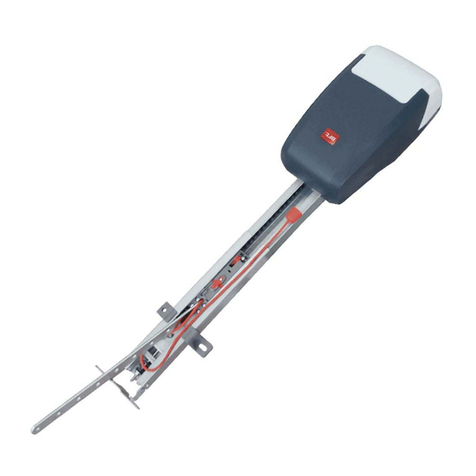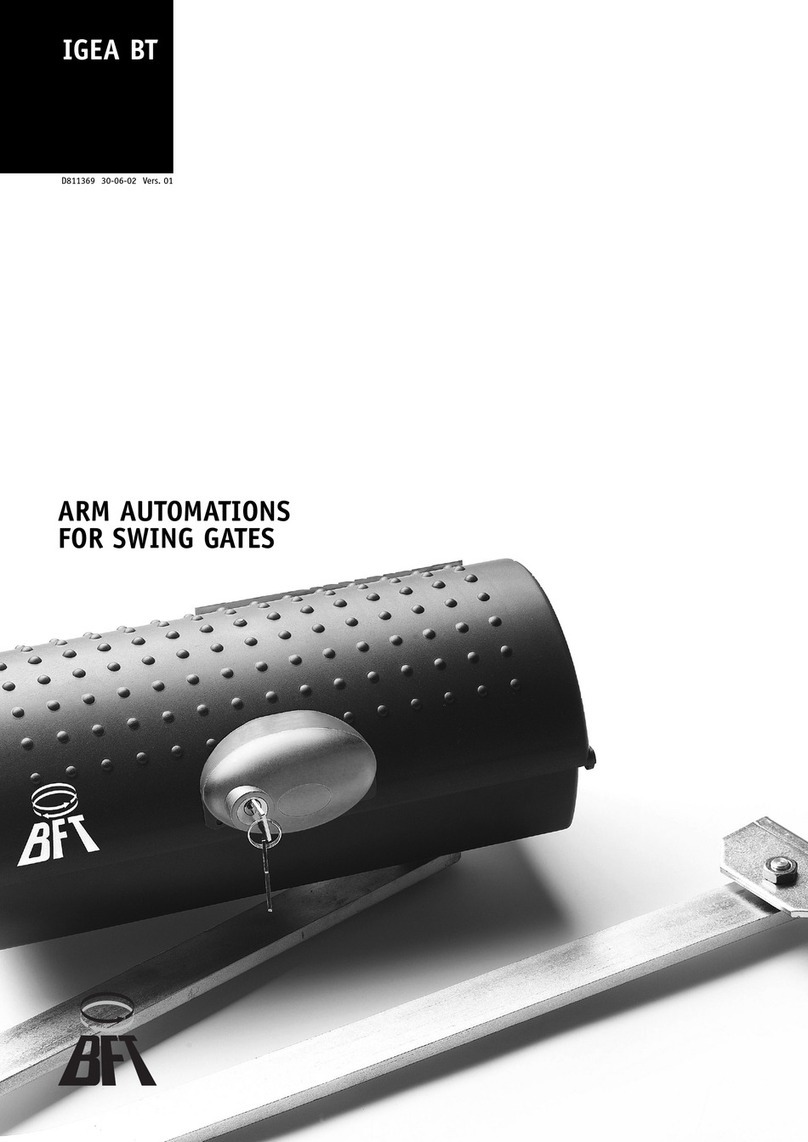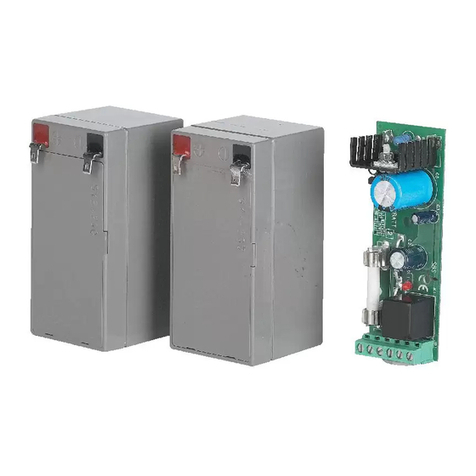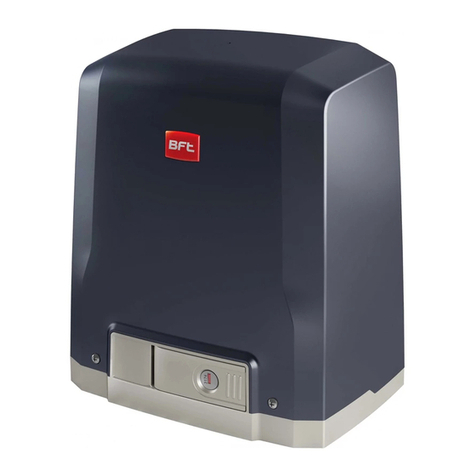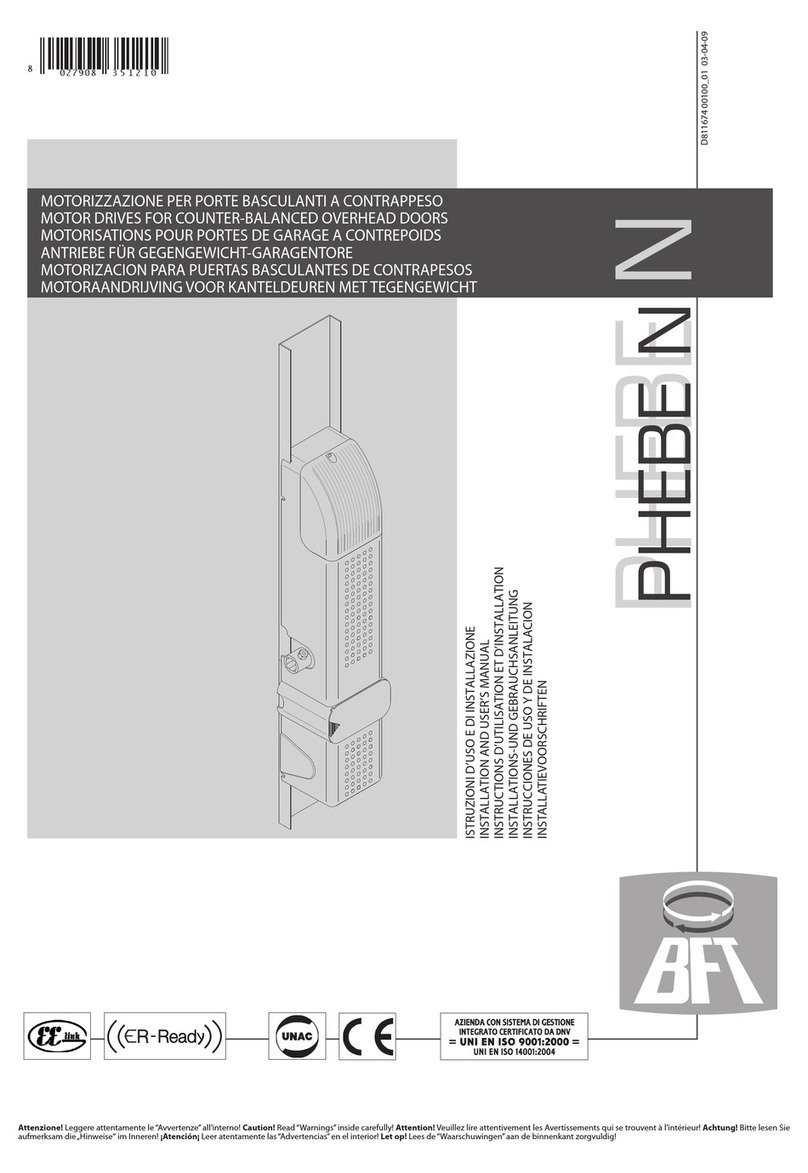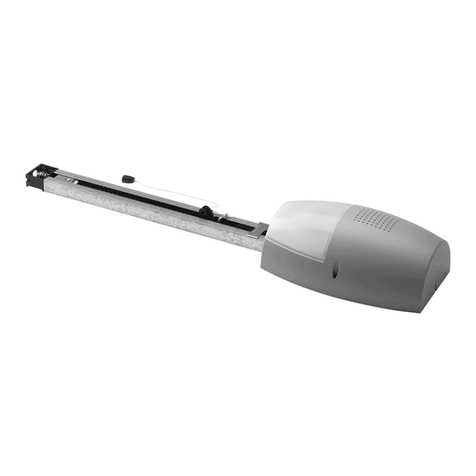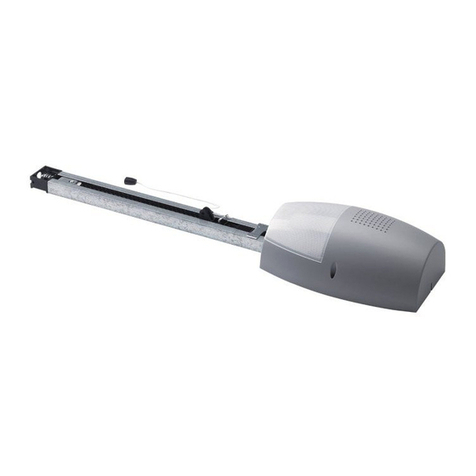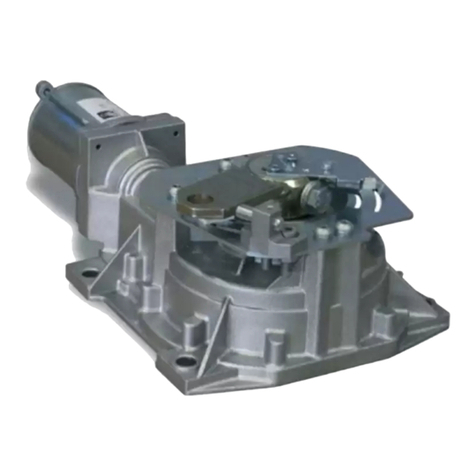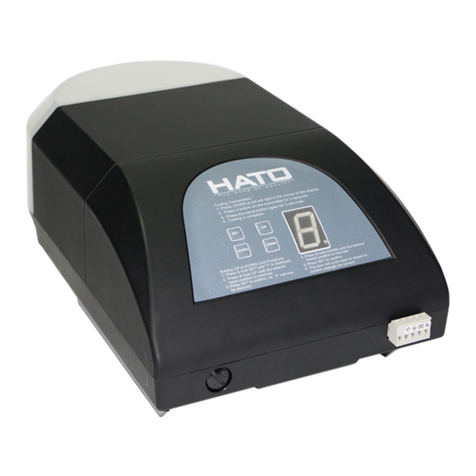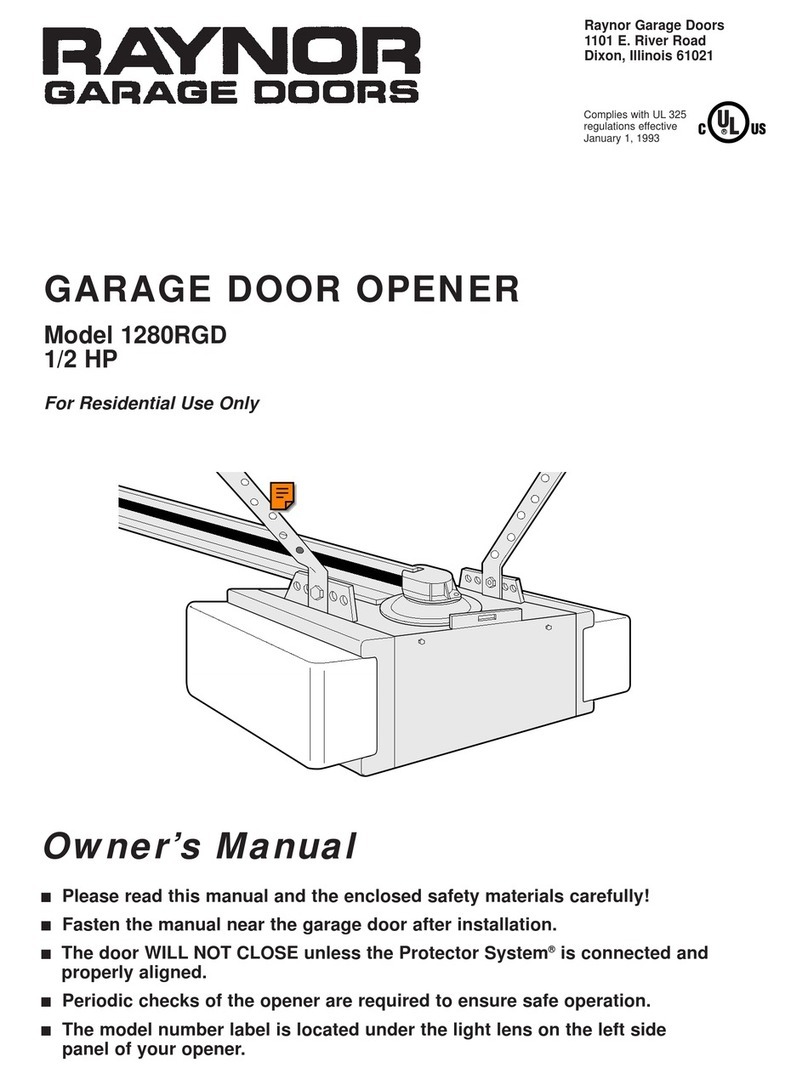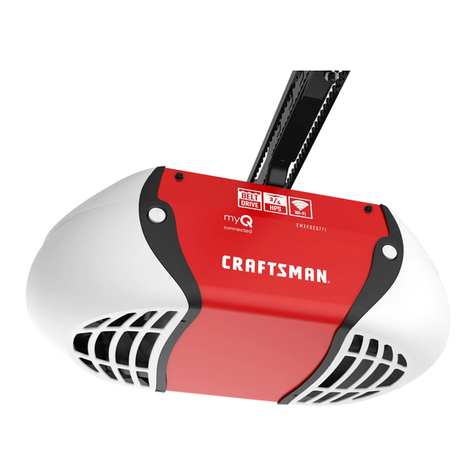MORSETTO DESCRIZIONE
JP2 cablaggio trasformatore
JP10 cablaggio motore
1-2 Ingressoantennaperschedaradioriceventeintegrata
(1:CALZA. 2: SEGNALE)
3-4 Ingresso START (N.O.)
3-5 Ingresso STOP (N.C.) Se non si utilizza lasciare il pon-
ticello inserito.
3-6 Ingresso FOTOCELLULA (N.C.) Se non si utilizza la-
sciare il ponticello inserito.
3-7 Ingresso FAULT (N.O.)
Ingresso per fotocellule dotate di contatto N.O. di
verica
8-9 Uscita 24 V~ per luce lampeggiante (25 W max)
10-11 Uscita 24V~ 180mA max - alimentazione fotocellule
o altri dispositivi.
12-13 Uscita 24V~ Vsafe 180mA max - alimentazione tra-
smettitori fotocellule con verica.
14-15 Uscita spia cancello aperto (Contatto NO) / 2° canale
radio.
16-17 Ingresso APERTURA PARZIALE (N.O.)
8) PROGRAMMAZIONE
Il quadro comandi dotato di microprocessore, viene fornito con parametri di
funzionamento preimpostati dal costruttore, validi per installazioni standard. I
parametripredenitipossono essere variatimedianteil programmatorea display
incorporato o mediante programmatore palmare uiversale.
/FMDBTPMBQSPHSBNNB[JPOFWFOHBFòFUUVBUBNFEJBOUFQSPHSBNNBUPSFQBMNBSFuiversale,leggereattentamenteleistruzionirelativeaunprogrammatorepalmare
uiversale e procedere come segue.
Collegare il programmatore palmare uiversale alla centralina tramite l’accessorio
UNIFLAT. Entrare nel menù“CENTRALINE”, nel sottomenù“PARAMETRI”e scorrere
le schermate del display con le frecce su/giù impostando numericamente i valori
dei parametri di seguito elencati.
Per le logiche di funzionamento, riferirsi al sottomenù“LOGICA”.
Nelcasosiprocedaallaprogrammazionemedianteilprogrammatoreincorporato
fare riferimento alla Fig. A e B e al paragrafo“congurazione”.
Di seguito si elenca il signicato ed i valori che possono essere assunti da ogni
parametro.
8.1 CONFIGURAZIONE
Il programmatore a display consente di impostare tutte le funzioni del quadro
comandi VENERE D.
Il programmatore dispone di tre pulsanti per la navigazione tra i menu e la con-
gurazione dei parametri di funzionamento:
+ tasto scorrimento menu/incremento valore
- tasto scorrimento menu/riduzione valore
0,UBTUPEJJOWJPDPOGFSNBLa pressione simultanea dei tasti + e - consente di uscire menu in cui si sta ope-
rando e passare al menu superiore.
Se la pressione simultanea dei tasti + e - avviene al livello principale dei menu
(parametri-logiche-radio-lingua-default-autosettaggio-regolazione necorsa),
si esce dalla programmazione e si spegne il display (viene visualizzato il mes-
saggio FINE).
Le modiche apportate vengono impostate solo se seguite dalla pressione del
UBTUP0,$POMBQSJNBQSFTTJPOFEFMUBTUP0,TJFOUSBJONPEBMJUËQSPHSBNNB[JPOFInizialmente sul display compaiono le seguenti informazioni:
- Versione Software centrale di comando
/VNFSPNBOPWSFUPUBMJFòFUUVBUFJMWBMPSFÒFTQSFTTPJONJHMJBJBRVJOEJdurante le prime mille manovre il display indica costantemente 0000
/VNFSPNBOPWSFFòFUUVBUFEBMMVMUJNBNBOVUFO[JPOFJMWBMPSFÒFTQSFTTPJOmigliaiaquindi duranteleprimemillemanovreildisplayindicacostantemente
0000.
- Numero radiocomandi memorizzati.
6OBQSFTTJPOFEFMUBTUP0,EVSBOUFMBGBTFEJQSFTFOUB[JPOFJOJ[JBMFDPOTFOUFdi passare direttamente al primo menu (parametri-logiche-radio-lingua-default-
autosettaggio-regolazione necorsa).
Di seguito vengono elencati i menu principali ed i relativi sottomenu disponi-
bili.
Il parametro predenito, è quello chiuso fra parentesi quadre [ 0 ]
Tra parentesi rotonde viene indicata la scritta che appare sul display.
Fate riferimento alle Figure A e B per la procedura di congurazione della cen-
trale.
8.2 Menu Parametri .0+
- Tempo Chiusura Automatica (2!) [ 40s ]
Impostare numericamente il valore del tempo di apertura automatica da 1 a
180 secondi.
- Coppia apertura (!MNNG?N) [ 50% ]
Impostare il valore di coppia di apertura del motore tra 1% e 99%.
- Coppia chiusura (!MNNG?!F) [ 50% ]
Impostare il valore di coppia di chiusura del motore tra 1% e 99%.
ATTENZIONE: Verificare che il valore della forza d’impatto
misuratoneipuntiprevistidallanormaEN12445,siainferiorea quanto
indicato nella norma EN 12453.
Una errata impostazione della sensibilità può creare danni
a persone, animali o cose.
- Apertura parziale ( ?NN?PX) [1,0 m]
Impostare numericamente il valore di apertura parziale da 10 cm (000,1) a 6
mt. (006.0)
- Zona (8MLC) [ 0 ]
Impostare il numero di zona tra un valore minimo di 0 ed un valore massimo
di 127. Vedi paragrafo 11 “Connessione seriale”.
- Velocità a regime in apertura (TCJ?N) [99%]
Imposta la velocità massima in apertura che raggiunge l’attuatore a regime.
Ilvaloreè espresso inpercentualesulla velocitàmassimaraggiungibiledall’at-
tuatore.
- Velocità a regime in chiusura (TCJAF) [99%]
Imposta la velocità massima in chiusura che raggiunge l’attuatore a regime.
Ilvaloreè espresso inpercentualesulla velocitàmassimaraggiungibiledall’at-
tuatore.
- Spazio di rallentamento (QN?XGMP?JJ) [007]
Imposta lo spazio di rallentamento in apertura e in chiusura che esegue
l’attuatore.
Il valore è espresso in centimetri.
La modica di uno di questi parametri:
- Velocità a regime in apertura
- Velocità a regime in chiusura
- Spazio di rallentamento
comporta una manovra completa dell’attuatore eseguita senza controllo anti-
schiacciamento. Questa manovra è contraddistinta dal lampeggio sul display
della scritta “SET”.
8.3 Menu Logiche *-%'!
- TCA (2!) [ OFF ]
ON: Attiva la chiusura automatica
OFF: Esclude la chiusura automatica.
- 3 Passi (.?QQG) [ OFF ]
ON:
Abilita la logica 3 passi.
6OJNQVMTPEJTUBSUIBJTFHVFOUJFòFUUJ
porta chiusa:.............................................................................................................apre
in apertura:........................................ferma ed inserisce il TCA (se congurato)
porta aperta:........................................................................................................ chiude
in chiusura:........................................................................... ferma e inverte il moto
dopo stop:.................................................................................................................apre
OFF: Disabilita logica 3 passi.
- Blocca Impulsi apertura ( J'KN.) [ OFF ]
0/-JNQVMTPEJTUBSUOPOIBBMDVOFòFUUPEVSBOUFMBGBTFEJBQFSUVSB0''-JNQVMTPEJTUBSUIBFòFUUPEVSBOUFMBGBTFEJBQFSUVSB- Pre allarme (NPCJJ) [ OFF ]
ON: Il lampeggiante si accende circa 3 secondi prima della partenza del mo-
tore.
OFF: Il lampeggiante si accende contemporaneamente alla partenza dei mo-
tori.
- Fotocellule in apertura ($MRMA?N) [ OFF ]
ON: in caso di oscuramento, esclude il funzionamento della fotocellula in
apertura. In fase di chiusura, inverte immediatamente.
OFF: in caso di oscuramento, le fotocellule sono attive sia in apertura che in
chiusura. Un oscuramento della fotocellula in chiusura, inverte il moto
solo dopo il disimpegno della fotocellula.
- Test fotocellule (RCQRNFMR) [ OFF ]
ON: Attiva la verica delle fotocellule (vedi g. 17A)
OFF: Disattiva la verica delle fotocellule
- Spia cancello aperto o II° canale radio (1!!F) [ ON ]
ON:
L’uscita tra i morsetti 14-15 viene congurata come Spia cancello aperto, il II°
canale radio in questo caso comanda l’apertura parziale.
OFF
:
L’uscita tra i morsetti
14-15
viene congurata come II° canale radio.
- Codice Fisso (AMBGACDGQQM) [ OFF ]
ON: Il ricevitore risulta congurato per il funzionamento in modalità codice sso,
vedi paragrafo“Clonazione dei Radiotrasmettitori”
OFF:
Il ricevitore risulta congurato per il funzionamento in modalità rolling-



